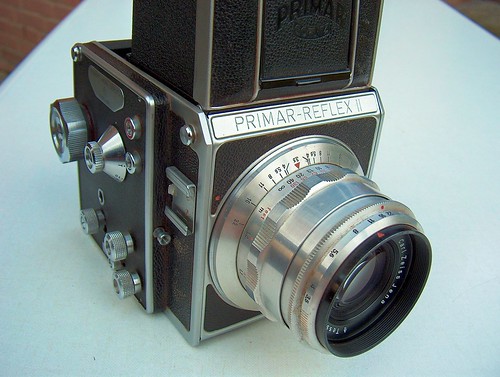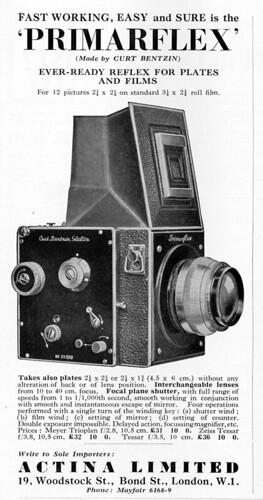Primarflex

|
| Primar-Reflex II from 1952 (identical to the Primarflex II) image by Gerard Vogels (Image rights) |
Contents
Camera
The Primarflex is a medium format reflex camera made by Bentzin in Görlitz, Germany. The company founder, Curt Bentzin, had manufactured an impressive line of cameras from 1889 on.
From its design the Primarflex is a cube to which a lens is added, an interesting concept which was new when the camera started its life in 1935.
The Primarflex was intended for professionals or ambitious amateurs. It was the inspiration for more modern medium format cameras like the Hasselblad, the Zenza Bronica and others.
Variants
Several model versions of the camera were produced: three prewar versions, and two postwar versions. All versions had subversions with slightly different looks, but they all were based on the first prewar model. After the war the camera was produced with a re-styled look before the final modernized model version came out in 1951. The production of the Primarflex ended in 1953. Over 18 years not more than 12.000 cameras were produced.
The postwar cameras produced for inside the DDR market (former German Democratic Republic) were labeled Primarflex II, while cameras for export outside the DDR were labeled Primar-Reflex II on the front plate. The camera was also sold in the USA re-labeled as Astraflex II and only a few as Peerflex.
After the war the company was expropriated and repeatedly reorganised as part of the state-owned system, eventually being part of VEB Feinoptisches Werk Görlitz. So the plate on the right side panel of the body shows different makers over the years: on prewar cameras it reads Curt Bentzin Görlitz and after the war: Kamera Werke Görlitz, or Primar Kamera Werke Görlitz (with or without the addition VEB), or Feinopt. Werk Görlitz. Additionally on later cameras the hood is impressed Primar Görlitz.
Features
Regarding the construction the Primarflex resembles the earlier, large wooden SLR cameras made by Bentzin from 1905 on. The early Primarflex cameras are built around a core of metal with surrounding panels of wood, later cameras had an all metal body. The body is covered with morocco leather. Reflex viewing is through the taking lens, on a full-size ground glass. Early models have an additional folding frame finder for different focal lengths mounted on top of the hood. It can be used as a sports finder when the hood is folded down. In postwar models this was replaced by a simplified arrangement of a folding panel in the front of the hood. Built-in magnifier in the hood. On later cameras the hood is removable to allow alternative finders to be fitted. These finders were announced, but never produced.
The camera takes 6×6 cm exposures on 120 film, but can also accept sheet film or plates.
On the right camera side there is the switchboard with the main controls. The most important operations are combined in one single winding-knob. It has to perform four operations: winding up the focal-plane shutter, transporting the film in the lengths of one picture, switching the film counter to further number and setting the mirror in the position ready for use. This all with one move – pretty cool in 1935. Shutter speeds from 1–1/1000 second, plus B and T. For the last 800 cameras the shutter speeds were corrected to more realistic 1–1/500 second. There is a lever for automatic release. The mirror can be brought down manually by a knob on the side plate.
Lenses

|
| 1938 advertisement image by Geoff Harrisson (Image rights) |
The Primarflex can use interchangeable lenses. The camera has a large lens mount with 70mm diameter. On the first models it was a screw mount, this was changed in 1939 to a broken thread (which worked like a bayonet) in the third prewar model. A large number of lenses with focal lengths from 8 cm to 50 cm were made for the camera. The well-known german makers Meyer and Zeiss made lenses for the Primarflex, but there were also lenses from: Arnz, Astro, Kilfitt, Novoflex, Piesker, Rodenstock, and Schneider. Others were made by various makers in France (Berthiot, Boyer, Krauss) and England (Dallmeyer, Ross, Taylor Hobson). All these lenses can be changed easily and can be used either on early or late models.
Links
- Primarflex (first prewar version, 1935), with 10.5 cm f/3.5 Tessar, at Early Photography.
- Primarflex (third prewar version), with 10.5 cm f/3.5 Tessar and a 32 cm f/6.3 Tele-Tessar, sold at the eighth Westlicht Photographica Auction, 27 November 2005.
- Primarflex (third prewar version), with 13.5 cm f/3.5 Tessar, at Collection Appareils by Sylvain Halgand (in French).
- Primarflex (1948 postwar version), with 10.5 cm f/3.5 and 16.5 cm f/3.5 Tessars, in a 2006 auction by Auction Team Breker in Cologne.
- Primarflex II with a 105 mm f/3.5 Tessar, in Oldguysphotos2, Old Man Dick's blog.
- Primarflex II at Industrie- und Filmmuseum Wolfen
- Primarflex 1940 advertising at Kurt Tauber's Kameramuseum
- Primarflex II instructions/booklet with accessories pricing (English) from OrphanCameras.com website.